- Home
- Stephen E. Ambrose
Nothing Like It in the World The Men Who Built the Transcontinental Railroad 1863-1869
Nothing Like It in the World The Men Who Built the Transcontinental Railroad 1863-1869 Read online
ALSO BY STEPHEN E. AMBROSE
Comrades: Brothers, Fathers, Heroes, Sons, Pals
The Victors: Eisenhower and His Boys: The Men of World War II
Americans at War
Citizen Soldiers: The U.S. Army from the Normandy Beaches to the Bulge to the Surrender of Germany, June 7, 1944-May 7, 1945
Undaunted Courage: Meriwether Lewis, Thomas Jefferson, and the Opening of the American West
D-Day: June 6, 1944: The Climactic Battle of World War II
Band of Brothers: E Company, 506th Regiment, 101st Airborne from Normandy to Hitler’s Eagle’s Nest
Nixon: Ruin and Recovery, 1973-1990
Eisenhower: Soldier and President
Nixon: The Triumph of a Politician, 1962-1972
Nixon: The Education of a Politician, 1913-1962
Pegasus Bridge: June 6, 1944
Eisenhower: The President
Eisenhower: Soldier, General of the Army, President-Elect, 1890-1952
The Supreme Commander: The War Years of General Dwight D. Eisenhower
Duty, Honor, Country: A History of West Point
Eisenhower and Berlin, 1945
Crazy Horse and Custer: The Parallel Lives of Two American Warriors
Rise to Globalism: American Foreign Policy, 1938-1992
Ike’s Spies: Eisenhower and the Espionage Establishment
Halleck: Lincoln’s Chief of Staff
Upton and the Army
SIMON & SCHUSTER
Rockefeller Center
1230 Avenue of the Americas
New York, NY 10020
www.SimonandSchuster.com
Copyright © 2000 by Ambrose-Tubbs, Inc.
Maps copyright © 2000 by Anita Karl and Jim Kemp
All rights reserved, including the right of reproduction in whole or in part in any form.
SIMON & SCHUSTER and colophon are registered trademarks of Simon & Schuster, Inc.
Designed by Karolina Harris
Manufactured in the United States of America
5 7 9 10 8 6 4
Library of Congress Cataloging-in-Publication Data
Ambrose, Stephen E.
Nothing like it in the world: the men who built the transcontinental railroad, 1863-1869 / Stephen E. Ambrose.
p. cm.
Includes bibliographical references and index.
1. Railroads—United States—History—19th century. 2. Central Pacific Railroad Company—History. 3. Union Pacific Railroad Company—History. 4. Railroad construction workers—United States—History—19th century. I. Title.
TF23 .A48 2000
385′.0973—dc2l 00-041005
ISBN 0-684-84609-8
eISBN: 978-0-743-21083-6
All photos are courtesy of the Union Pacific Museum Collection. A leatherbound signed first edition of this book has been published by Easton Press.
Acknowledgments
SOME years ago, when I handed the manuscript of my latest book in to my editor at Simon & Schuster, Alice Mayhew, she said she wanted me to do the building of the first transcontinental railroad for my next book. Even though I had been trained as a nineteenth-century American historian, I hesitated. First of all, I had been taught to regard the railroad builders as the models for Daddy Warbucks. The investors and builders had made obscene profits which they used to dominate state and national politics to a degree unprecedented before or since. John Robinson’s book The Octopus: A History of Construction, Conspiracies, Extortion, about the way the Big Four ruined California, expressed what I thought and felt. What made the record of the big shots so much worse was that it was the people’s money they stole, in the form of government bonds and land. In my view, opposition to the Union Pacific and the Central Pacific (later the Southern Pacific) had led to the Populist Party and then the Progressive Party, political organizations that I regarded as the saviors of America. I wanted nothing to do with those railroad thieves.
I told Alice to give me six months to read the major items in the literature, so I could see if there was a reason for a new or another book on the subject. So I read. In the process I changed my mind about many aspects of building the railroads and the men who got rich from investing in them. And I was delighted by the works in the basic literature. Most of them I quote from, and they can be found in the bibliography.
I do need to make a specific mention of Maury Klein, whose magnificent two-volume history of the Union Pacific is a superb work for the general reader and the specialist or the writer. It is an absorbing story, beautifully told. Klein is a model for scholarship, for writing, and for thinking his subject through before making a statement. George Kraus, High Road to Promontory: Building the Central Pacific Across the High Sierra, is the basic source on the subject. There are many fine researchers and writers who have published books on the Union Pacific and Central Pacific roads. The two who have my gratitude and respect ahead of all others are Maury Klein and George Kraus.
After the reading, I decided that there was a lot of good literature already in existence on the railroads and that I could use it for stories, incidents, sources, and quotes, but none of the books were done in the way I was looking for. If I really wanted to know at least a part of the answer to Alice’s question, How did they build that railroad?—rather than How did they profit from it? or How did they use their power for political goals?—I was going to have to write my own book to find out. So I did.
I have first of all to acknowledge that this book is Alice’s idea. She didn’t do the writing, to be sure, or try to guide my research or to suggest ideas for me to investigate or incorporate. She didn’t hurry me, even though I had a bad fall in the middle of doing this book that put me out of action for a few months. She read chapters as I sent them in, and gave me encouragement, which was a great help, since I write for her. If she likes what comes out of my writing, I’m pleased. If she doesn’t, I try again. But above all, she let me figure out the answer to her question.
My research assistants are all part of my family. First my wife, Moira, who always participated, making suggestions, offering ideas, listening and commenting, being there. Then my research assistant and son, Hugh Alexander Ambrose. Hugh is a trained historian, with his Master’s degree in American history from the University of Montana. He did the basic research at the Library of Congress for me, and at the Bancroft Library on the University of California campus, and at Huntington Library, at the Archives at the Library of the Church of Latter-Day Saints in Salt Lake City, and on the World Wide Web. He mastered the literature, and he was my first reader on all the chapters. His many suggestions have been absorbed in the text. Without him there would be no book.
My son Barry Ambrose, my daughter-in-law Celeste, my older daughter, Stephenie, my niece Edie Ambrose (a Ph.D. in American history from Tulane), and another daughter-in-law, Anne Ambrose, all participated in the newspaper and magazine research. Edie read early chapters and gave me solid suggestions on everything from word choices to interpretations. I had decided at the beginning that this book was like doing Lewis and Clark, but unlike D-Day or my books on Cold War politics. Different in this way: there was no one around who had been there and could say, I saw this with my own eyes. I couldn’t do any interviewing.
Next best thing, I thought, were the newspaper reporters. I knew that many big-city papers sent their own correspondents out west to report on how the railroad was being built. Reporters are always looking for what is new, what is fre
sh, asking questions, trying to anticipate questions. So Celeste, Barry, Edie, Anne, and Stephenie started reading 130-year-old newspapers on dusty microfilm readers. They found a lot of information and stories that I used throughout the book. They are diligent, imaginative, creative in going through the newspapers, and, like all researchers, they learn a lot in the process. I hasten to add that they get paid for their time and effort, but I must confess that I am defeated in any attempt to thank them enough.
I need to thank the librarians at the University of Montana, the Missoula City Library, the Helena Public Library, Bonnie Hardwick at the Bancroft Library at the University of California in Berkeley, Susi Krasnoo, Dan Lewis, and the staff at the Huntington Library in Pasadena, Jeffrey Spencer at the historic General Dodge House in Council Bluffs, Iowa, Lee Mortensen of the Nevada Historical Society in Reno, the staff of the California State Railroad Museum Library in Sacramento, Richard Sharp at the Library of Congress, Bill Slaughter at the Archives, Church of Latter Day Saints Library, the Hancock County Library in Bay St. Louis, Mississippi, and the staffs of many county historical or city historical museums that Hugh and I visited in 1997-98.
Ana DeBevoise, on Alice Mayhew’s staff, has been a continual source of support, good thinking, and cheerfulness. The people at Simon & Schuster, from Carolyn Reidy and David Rosenthal on down, have done their usual and as always quite superb and professional job, which I have come to expect but which always makes me feel so lucky. Thanks to all of them.
A heartfelt thanks to the men and women who run the railroad museums in Sacramento (one of the best) and Ogden (also among the best) and Omaha (ditto). Hugh and I spent days examining the exhibits, learning, asking questions.
Many railroad buffs were kind enough to send along information. Among them, Nathan Mazer, Bruce Cooper, and Ray Haycox, Jr. A special thanks to Brad Joseph, who built two wonderful models for me, one of the Golden Spike scene at Promontory, Utah, and the other of the drive of the Central Pacific over the Sierra Nevada mountains. Others who helped in various ways are Helen Wayland of the Colfax Historical Society and Joel Skornika of the Center for Railroad Photography and Art, Madison, Wisconsin.
Hugh and I are grateful to Chairman Richard Davidson, Ike Evans, Dennis Duffy, Carl Bradley, Brenda Mainwaring and Dave Bowler of the Union Pacific, and Philip Anschutz of the Anschutz Corporation, for making it possible for us to ride the rails. I wanted to see the track and grade from up front on a train on the original line. Thanks to Davidson and the UP people, as well as my dear friend Ken Rendell, we rode in the engine on a Union Pacific diesel locomotive from Sacramento to Sparks, Nevada (right next to Reno). Together Ken, Hugh, and I were in the cab (with engineers Larry Mireles and Mike Metzger), going around California’s Cape Horn, climbing and descending the Sierra Nevada, having experiences of sight, sound, and touch that will never be forgotten.
At one point Mr. Mike Furtney of the railroad company, who was with us, said to me, “You know, Steve, there are thousands of men in this country who would pay us anything we might choose to ask to be up here on this ride.” I said I knew that, although at the time I was not aware of just how many train enthusiasts there are in the country. Mike said, “You take the controls for a while.” I said I wouldn’t dare. He said the engineer would be right behind me, and insisted. So I got to drive a train up the Sierra Nevada, tooting on the whistle before every crossing. Somehow they didn’t allow me to stay at the controls for the trip down the mountain.
On the return trip, led by Dave Bowler, we got off and walked through the tunnel at the summit—No. 6, as it was called in 1867. We picked up some spikes and a fishplate. For anyone who has been there and is aware of how men armed only with drills, sledgehammers, and black powder drove a tunnel through that mountain, it is a source of awe and astonishment.
Mr. Davidson gave me and Moira permission to ride in a special train going from Omaha to Sacramento for a steam-engine display. The locomotive would be No. 844, with the legendary Stephen Lee as engineer. The fireman was Lynn Nystrom. This was the last steam engine bought by the UP—in 1943—and it was used until the late 1950s, then neglected, then restored to become the pride of the railroad today.
We rode from Omaha to Sparks in such splendor as we had never imagined. Ken Rendell was with us for the first half of the trip, Richard Lamm for the second. Bob Kreiger was the engineer for the second cab, also steam, called No. 3985.
For the most part we rode in the cab, pulling into sidings for the night. It was extraordinary. I counted more than thirty-seven handles and knobs on the cab’s panel in front of me, none with an explanation of how they worked or why they were there. But throughout the trip Steve Lee would adjust them without looking at them.
The engine is sacred for many reasons. It is in the cab of a locomotive that a mere man can control all that power, it is from there and there only that a man riding on a train can see ahead. It is the eyes, ears, brains, motor power, and central nervous system for the long string of cars it is pulling along.
To be in the locomotive of a steam-driven train, riding from Omaha to Reno, was for me, Moira, Ken, and Dick a memorable experience. First of all, Steve Lee and Lynn Nystrom are big guys, 250 or more pounds each, who put every ounce of themselves into their job, which they love more than nearly anyone I’ve ever met. They are impressive because of their size, their skill, and their personalities. Nearly all the towns we went through in Nebraska, Wyoming, Utah, and Nevada are railroad towns, and so far as we could tell every adult living there knew Steve, Bob, and Lynn. The engineers would whistle, the spectators would wave.
What impressed me the most, however, was the size of the crowds. The local newspaper or the radio station had a small item the day before the UP’s 844 came through, announcing the trip. From what we could tell, every resident was beside the tracks, or up on a ridge we passed under, or out on a bluff that offered a view. Thousands of spectators. Tens of thousands. Among them were all ages and people from both sexes, every one of them with a camera.
I’ve led a life that makes me accustomed to people pointing cameras at me because of the man I’m with, whether a movie star or director or a top politician. I’ve never known anything like this. The size of the crowds, their curiosity, their involvement in the scene were stunning. Much of the time we were paralleling Interstate 80. When that happened, we caused a traffic jam. People went just as fast as the train—at sixty-one miles per hour—and gaped. At one point the automobiles were lined up seven full miles behind us. At rest stops, we would see semi-truck drivers on top of their vans, taking pictures with their little cameras. I asked Steve Lee if he had ever stopped to take a picture of a semi-truck. He said no. He added that the semi-truck drivers never stopped to take a picture of a diesel locomotive.
It was then I learned how America has lost her heart to steam-driven locomotives.
One day on the trip we left the 844 for an afternoon in Cheyenne to go by automobile to the Ames Monument and then on to the site of the Dale Creek Bridge. We walked through the cuts that led to the bridge, where we gathered up some spikes and other items. The gorge itself is more than formidable. I can’t imagine any twenty-first-century engineer deciding to put a bridge across it. I’m sure there are some who might, but I don’t know them.
The most memorable feature of the trip was the presence of Don Snoddy, the historian of the Union Pacific, and Lynn Farrar, who held the same post for decades at the Southern Pacific. They ate meals with us, were with us in the observation car, sat with us at various sidings, and talked. They are wonderful sources. They know damn near everything about the railroads. As one example, riding north of Laramie, they began pointing out grading that had been abandoned. Every town on the line had a story to go with it. Don and Lynn pointed out what happened here, there, all over. They talked about how this was built, and that, or what this or that slang word meant. And anything else. It was a thrill for us to be with them for a week. Then they read the script and saved me from many, many erro
rs. Don was also the driving force behind the trip from Omaha to Ogden.
My thanks to the Union Pacific for making it possible for me and Moira to take the trip that will always sparkle above all others for us.
Dedication
For Alice Mayhew
Contents
Introduction
ONE PICKING THE ROUTE 1830-1860
TWO GETTING TO CALIFORNIA 1848-1859
THREE THE BIRTH OF THE CENTRAL PACIFIC 1860-1862
FOUR THE BIRTH OF THE UNION PACIFIC 1862-1864
FIVE JUDAH AND THE ELEPHANT 1862-1864
SIX LAYING OUT THE UNION PACIFIC LINE 1864-1865
SEVEN THE CENTRAL PACIFIC ATTACKS THE SIERRA NEVADA 1865
EIGHT THE UNION PACIFIC ACROSS NEBRASKA 1866
NINE THE CENTRAL PACIFIC ASSAULTS THE SIERRA 1866
TEN THE UNION PACIFIC TO THE ROCKY MOUNTAINS 1867
ELEVEN THE CENTRAL PACIFIC PENETRATES THE SUMMIT 1867
TWELVE THE UNION PACIFIC ACROSS WYOMING 1868
THIRTEEN BRIGHAM YOUNG AND THE MORMONS MAKE THE GRADE 1868
FOURTEEN THE CENTRAL PACIFIC GOES THROUGH NEVADA 1868
FIFTEEN THE RAILROADS RACE INTO UTAH JANUARY 1—APRIL 10, 1869
SIXTEEN TO THE SUMMIT APRIL 11-MAY 7, 1869
SEVENTEEN DONE MAY 8-10, 1869
Epilogue
Notes
Bibliography
Index
MAPS
From Chicago to Omaha
Nebraska
Wyoming
Nevada
Utah
California
Introduction
NEXT to winning the Civil War and abolishing slavery, building the first transcontinental railroad, from Omaha, Nebraska, to Sacramento, California, was the greatest achievement of the American people in the nineteenth century. Not until the completion of the Panama Canal in the early twentieth century was it rivaled as an engineering feat.
The railroad took brains, muscle, and sweat in quantities and scope never before put into a single project. It could not have been done without a representative, democratic political system; without skilled and ambitious engineers, most of whom had learned their craft in American colleges and honed it in the war; without bosses and foremen who had learned how to organize and lead men as officers in the Civil War; without free labor; without hardworking laborers who had learned how to take orders in the war; without those who came over to America in the thousands from China, seeking a fortune; without laborers speaking many languages and coming to America from every inhabited continent; without the trees and iron available in America; without capitalists willing to take high risks for great profit; without men willing to challenge all, at every level, in order to win all. Most of all, it could not have been done without teamwork.

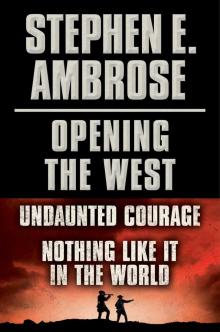 Undaunted Courage
Undaunted Courage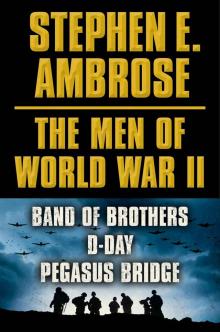 The Victors: Eisenhower and His Boys
The Victors: Eisenhower and His Boys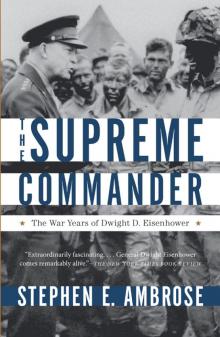 The Supreme Commander
The Supreme Commander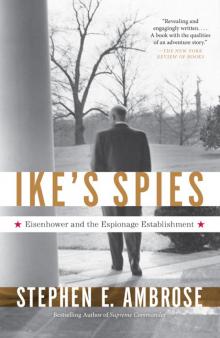 Ike's Spies: Eisenhower and the Espionage Establishment
Ike's Spies: Eisenhower and the Espionage Establishment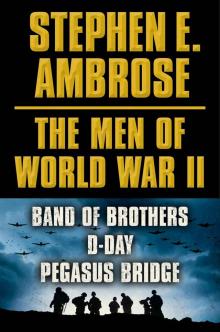 The Men of World War II
The Men of World War II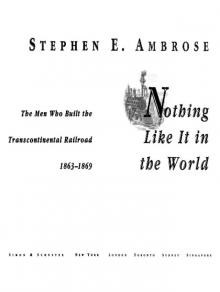 Nothing Like It in the World The Men Who Built the Transcontinental Railroad 1863-1869
Nothing Like It in the World The Men Who Built the Transcontinental Railroad 1863-1869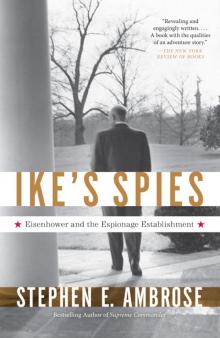 Ike's Spies
Ike's Spies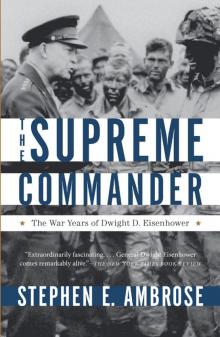 Supreme Commander
Supreme Commander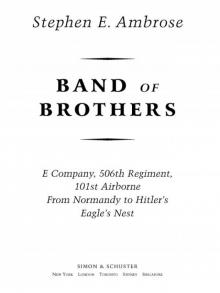 Band of Brothers
Band of Brothers